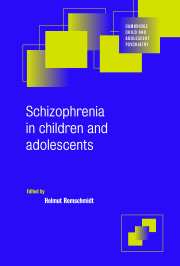Book contents
- Frontmatter
- Contents
- List of contributors
- Preface
- 1 Childhood psychosis and schizophrenia: a historical review
- 2 Definition and classification
- 3 Epidemiology of early onset schizophrenia
- 4 Childhood schizophrenia: developmental aspects
- 5 Diagnosis and differential diagnosis
- 6 Genetic aspects
- 7 Neurobehavioral perspective
- 8 Psychosocial factors: the social context of child and adolescent onset schizophrenia
- 9 Treatment and rehabilitation
- 10 Course and prognosis
- Index
8 - Psychosocial factors: the social context of child and adolescent onset schizophrenia
Published online by Cambridge University Press: 23 October 2009
- Frontmatter
- Contents
- List of contributors
- Preface
- 1 Childhood psychosis and schizophrenia: a historical review
- 2 Definition and classification
- 3 Epidemiology of early onset schizophrenia
- 4 Childhood schizophrenia: developmental aspects
- 5 Diagnosis and differential diagnosis
- 6 Genetic aspects
- 7 Neurobehavioral perspective
- 8 Psychosocial factors: the social context of child and adolescent onset schizophrenia
- 9 Treatment and rehabilitation
- 10 Course and prognosis
- Index
Summary
Introduction
Scientific advances over recent years have contributed to an emerging consensus that schizophrenia is a biologically based disorder. This biologically based view has been complemented, however, by accumulating research demonstrating that: (i) the disorder has a profound effect on the adolescent's psychosocial functioning, and (ii) the psychosocial environment in which an adolescent develops has a major impact on the expression of the disorder (for review, see Asarnow, 1994). Furthermore, the current emphasis on treating adolescents within the least restrictive setting has highlighted the stressors involved in rearing adolescents with schizophrenia and the need to attend to stress levels and coping efforts among parents, siblings, and other family members who are critical partners in the treatment process.
This chapter focuses on psychosocial factors in child and adolescent onset schizophrenia with the goal of highlighting promising psychosocial treatment strategies. We begin by examining current knowledge with respect to the psychosocial functioning of adolescents with schizophrenia. Secondly, we review current models for the psychosocial treatment of schizophrenia. Thirdly, we turn to the implications of current knowledge for the psychosocial treatment of adolescents with schizophrenia and conclude by offering suggestions regarding future directions for clinical research and treatment.
Schizophrenia in adolescence: psychosocial functioning and developmental progressions
Consider the following descriptions of the psychosocial impairments experienced by adolescents with schizophrenia:
Impaired academic and school functioning
All of a sudden I couldn't read or write or do maths anymore. Everything was so confusing because I couldn't understand anything that was going on around me
(Anonymous, 1994, p. 587).Keywords
- Type
- Chapter
- Information
- Schizophrenia in Children and Adolescents , pp. 168 - 191Publisher: Cambridge University PressPrint publication year: 2000
- 1
- Cited by

